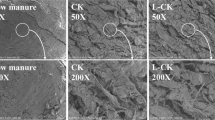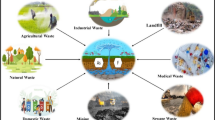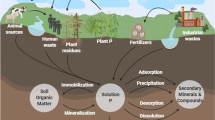Abstract
The processes of acid in situ leaching (ISL) uranium (U) mines cause the pollution of groundwater. Phosphate (PO43−) has the potential to immobilize U in groundwater through forming highly insoluble phosphate minerals, but the performance is highly restricted by low pH and high sulfate concentration. In this study, hydrogen peroxide (H2O2) and PO43− were synergistically used for immobilizing U based on the specific properties of groundwater from a decommissioned acid ISL U mine. The removal mechanisms of U and the stability of U on the formed minerals were elucidated by employing X-ray diffraction, scanning electron microscopy, X-ray photoelectron spectroscopy and kinetic experiments. Our results indicated that the removal of U by simultaneously adding H2O2 and PO43− was significantly higher than the removal of U by individually adding H2O2 or PO43−. The removal of U increased with increasing PO43− concentration from 20 to 200 mg L−1 while decreased with increasing H2O2 concentration from 0.003 to 0.3%. Specifically, the removal efficiency of U from groundwater reached 98% after the application of 0.003% H2O2 and 200 mg L−1 PO43−. Amorphous iron phosphate that preferentially formed at low H2O2 and high PO43− concentrations played a dominant role in U removal, while the formations of schwertmannite and crystalline iron phosphates may be also contributed to the removal of U. This was significantly different from the immobilization mechanism of U through the formation of uranyl phosphate minerals after adding phosphate. The kinetic experimental results suggested that the immobilized U had a good stability. Our research may provide a promising method for in situ remediating U-contaminated groundwater at the decommissioned acid ISL U mines.






Similar content being viewed by others
Data availability
Data and materials can be made available upon request.
References
Ahmed B, Cao B, Mishra B, Boyanov MI, Kemner KM, Fredrickson JK, Beyenal H (2012) Immobilization of U(VI) from oxic groundwater by Hanford 300 Area sediments and effects of Columbia River water. Water Res 46:3989–3998
Ansoborlo E, Lebaron-Jacobs L, Prat O (2015) Uranium in drinking-water: a unique case of guideline value increases and discrepancies between chemical and radiochemical guidelines. Environ Int 77:1–4
Ben Simon R, Thiry M, Schmitt JM, Lagneau V, Langlais V, Bélières M (2014) Kinetic reactive transport modelling of column tests for uranium In Situ Recovery (ISR) mining. Appl Geochem 51:116–129
Blgham JM, Schwertmann U, Carlson L, Murad E (1990) A poorly crystallized oxyhydroxysulfate of iron formed by bacterial oxidation of Fe(II) in acid mine waters. Geochim Cosmochim Acta 54:2743–2758
Boily JF, Gassman PL, Peretyazhko T, Szanyi J, Zachara JM (2010) FTIR spectral components of schwertmannite. Environ Sci Technol 44:1185–1190
Bolloju S, Rohan R, Wu ST, Yen HX, Dwivedi GD, Lin YA, Lee JT (2016) A green and facile approach for hydrothermal synthesis of LiFePO4 using iron metal directly. Electrochim Acta 220:164–168
Borch T, Roche N, Johnson TE (2012) Determination of contaminant levels and remediation efficacy in groundwater at a former in situ recovery uranium mine. J Environ Monit 14:1814–1823
Campos PV, Albuquerque ARL, Angélica RS, Paz SPA (2021) FTIR spectral signatures of amazon inorganic phosphates: igneous, weathering, and biogenetic origin. Spectrochim Acta A 251:119476
Crane RA, Dickinson M, Popescu IC, Scott TB (2011) Magnetite and zero-valent iron nanoparticles for the remediation of uranium contaminated environmental water. Water Res 45:2931–2942
Ding DX, Li SM, Hu N, Xu F, Li GY, Wang YD (2015) Bioreduction of U(VI) in groundwater under anoxic conditions from a decommissioned in situ leaching uranium mine. Bioprocess Biosyst Eng 38:661–669
Fanizza MF, Yoon H, Zhang C, Oostrom M, Wietsma TW, Hess NJ, Bowden ME, Strathmann TJ, Finneran KT, Werth CJ (2008) Pore-scale evaluation of uranyl phosphate precipitation in a model groundwater system. Water Resour Res 49:874–890
Foster RI, Kim KW, Oh MK, Lee KY (2019) Effective removal of uranium via phosphate addition for the treatment of uranium laden process effluents. Water Res 158:82–93
Fuller CC, Bargar JR, Davis JA, Piana MJ (2002) Mechanisms of uranium interactions with hydroxyapatite: implications for groundwater remediation. Environ Sci Technol 36:158–165
Gallegos TJ, Campbell KM, Zielinski RA, Reimus PW, Clay JT, Janot N, Bargar JR, Benzel WM (2015) Persistent U(IV) and U(VI) following in-situ recovery (ISR) mining of a sandstone uranium deposit, Wyoming, USA. Appl Geochem 63:222–234
Han M, Kong L, Hu X, Chen D, Xiong X, Zhang H, Su M, Diao Z, Ruan Y (2018) Phase migration and transformation of uranium in mineralized immobilization by wasted bio-hydroxyapatite. J Clean Prod 197:886–894
Jönsson J, Persson P, Sjöberg S, Lövgren L (2005) Schwertmannite precipitated from acid mine drainage: phase transformation, sulphate release and surface properties. Appl Geochem 20:179–191
Kanematsu M, Perdrial N, Um W, Chorover J, O’Day PA (2014) Influence of phosphate and silica on U(VI) precipitation from acidic and neutralized wastewaters. Environ Sci Technol 48:6097–6106
Klimkova S, Cernik M, Lacinova L, Filip J, Jancik D, Zboril R (2011) Zero-valent iron nanoparticles in treatment of acid mine water from in situ uranium leaching. Chemosphere 82:1178–1184
Kumpulainen S, von der Kammer F, Hofmann T (2008) Humic acid adsorption and surface charge effects on schwertmannite and goethite in acid sulphate waters. Water Res 42:2051–2060
Li X, Guo C, Jin X, He C, Yao Q, Lu G, Dang Z (2021) Mechanisms of Cr(VI) adsorption on schwertmannite under environmental disturbance: changes in surface complex structures. J Hazard Mater 416:125781
Liao Q, Wang F, Chen PS, Zhu H, Lu M, Qin J (2015) FTIR spectra and properties of iron borophosphate glasses containing simulated nuclear wastes. J Mol Struct 1092:187–191
Maarouf F, Saoiabi S, Azzaoui K, Chrika C, Khalil H, Elkaouni S, Lhimr S, Boubker O, Hammouti B, Jodeh S (2021) Statistical optimization of amorphous iron phosphate: inorganic sol–gel synthesis-sodium potential insertion. BMC Chem 15:1–14
Mehta VS, Maillot F, Wang Z, Catalano JG, Giammar DE (2014) Effect of co-solutes on the products and solubility of uranium(VI) precipitated with phosphate. Chem Geol 364:66–75
Mehta VS, Maillot F, Wang Z, Catalano JG, Giammar DE (2015) Transport of U(VI) through sediments amended with phosphate to induce in situ uranium immobilization. Water Res 69:307–317
Mehta VS, Maillot F, Wang Z, Catalano JG, Giammar DE (2016) Effect of reaction pathway on the extent and mechanism of Uranium(VI) immobilization with calcium and phosphate. Environ Sci Technol 50:3128–3136
Mudd GM (2001a) Critical review of acid in situ leach uranium mining: 1. USA and Australia Environ Geol 41:390–403
Mudd GM (2001b) Critical review of acid in situ leach uranium mining: 2. Soviet Block and Asia Environ Geol 41:404–416
Ohnuki T, Kozai N, Samadfam M, Yasuda R, Yamamoto S, Narumi K, Naramoto H, Murakami T (2004) The formation of autunite (Ca(UO2)2(PO4)2·nH2O) within the leached layer of dissolving apatite: incorporation mechanism of uranium by apatite. Chem Geol 211:1–14
Palacios E, Leret P, Fernández JF, De Aza AH, Rodríguez MA (2012) Synthesis of amorphous acid iron phosphate nanoparticles. J Nanopart Res 14:1131
Ram R, Charalambous F, Tardio J, Bhargava S (2011) An investigation on the effects of Fe (FeIII, FeII) and oxidation reduction potential on the dissolution of synthetic uraninite (UO2). Hydrometallurgy 109:125–130
Reimus PW, Dangelmayr MA, Clay JT, Chamberlain KR (2019) Uranium natural attenuation downgradient of an in situ recovery mine inferred from a cross-hole field test. Environ Sci Technol 53:7483–7493
Rossberg A, Ulrich KU, Weiss S, Tsushima S, Hiemstra T, Scheinostt AC (2009) Identification of uranyl surface complexes on ferrihydrite: Advanced EXAFS data analysis and CD-MUSIC modeling. Environ Sci Technol 43:1400–1406
Rudin T, Pratsinis SE (2012) Homogeneous iron phosphate nanoparticles by combustion of sprays. Ind Eng Chem Res 51:7891–7900
Ruiz O, Thomson B, Cerrato JM, Rodriguez-Freire L (2019) Groundwater restoration following in-situ recovery (ISR) mining of uranium. Appl Geochem 109:104418
Saunders JA, Pivetz BE, Voorhies N, Wilkin RT (2016) Potential aquifer vulnerability in regions down-gradient from uranium in situ recovery (ISR) sites. J Environ Manage 183:67–83
Seder-Colomina M, Morin G, Brest J, Ona-Nguema G, Gordien N, Pernelle JJ, Banerjee D, Mathon O, Esposito G, van Hullebusch ED (2015) Uranium (VI) scavenging by amorphous iron phosphate encrusting Sphaerotilus natans filaments. Environ Sci Technol 49:14065–14075
Seredkin M, Zabolotsky A, Jeffress G (2016) In situ recovery, an alternative to conventional methods of mining: exploration, resource estimation, environmental issues, project evaluation and economics. Ore Geol Rev 79:500–514
Sharp JO, Lezama-Pacheco JS, Schofield EJ, Junier P, Ulrich KU, Chinni S, Veeramani H, Margot-Roquier C, Webb SM, Tebo BM, Giammar DE, Bargar JR, Bernier-Latmani R (2011) Uranium speciation and stability after reductive immobilization in aquifer sediments. Geochim Cosmochim Acta 75:6497–6510
Singh A, Catalano JG, Ulrich KU, Giammar DE (2012) Molecular-scale structure of uranium(VI) immobilized with goethite and phosphate. Environ Sci Technol 46:6594–6603
Singh A, Ulrich KU, Giammar DE (2010) Impact of phosphate on U(VI) immobilization in the presence of goethite. Geochim Cosmochim Acta 74:6324–6343
Su X, Li X, Ma L, Fan J (2019) Formation and transformation of schwertmannite in the classic Fenton process. J Environ Sci 82:145–154
Taylor G, Farrington V, Woods P, Ring R, Molloy R (2004) Review of environmental impacts of the acid in situ leach uranium mining process. In: CSIRO Land and Water Client Report. CSIRO, Clayton, Victoria, p 60
Thinnappan V, Merrifield CM, Islam FS, Polya DA, Wincott P, Wogelius RA (2008) A combined experimental study of vivianite and As (V) reactivity in the pH range 2–11. Appl Geochem 23:3187–3204
Tian L, Shi Z, Lu Y, Dohnalkova AC, Lin Z, Dang Z (2017) Kinetics of cation and oxyanion adsorption and desorption on ferrihydrite: roles of ferrihydrite binding sites and a unified model. Environ Sci Technol 51:10605–10614
Voegelin A, Kaegi R, Frommer J, Vantelon D, Hug SJ (2010) Effect of phosphate, silicate, and Ca on Fe(III)-precipitates formed in aerated Fe(II)- and As(III)-containing water studied by X-ray absorption spectroscopy. Geochim Cosmochim Acta 74:164–186
Voegelin A, Senn AC, Kaegi R, Hug SJ, Mangold S (2013) Dynamic Fe-precipitate formation induced by Fe(II) oxidation in aerated phosphate-containing water. Geochim Cosmochim Acta 117:216–231
Wang P, Lu Y, Hu S, Tian L, Liang Y, Shi Z (2020) Kinetics of Ni reaction with organic matter-ferrihydrite composites: experiments and modeling. Chem Eng J 379:122306
Wang X, Gu C, Feng X, Zhu M (2015) Sulfate local coordination environment in schwertmannite. Environ Sci Technol 49:10440–10448
Xie Y, Lu G, Ye H, Yang C, Xia D, Yi X, Reinfelder J, Dang Z (2017) Fulvic acid induced the liberation of chromium from CrO42−-substituted schwertmannite. Chem Geol 475:52–61
Xie Y, Ye H, Wen Z, Dang Z, Lu G (2022) Sulfide-induced repartition of chromium associated with schwertmannite in acid mine drainage: impacts and mechanisms. Sci Total Environ 848:157863
Xing C, Shi J, Cui F, Shen J, Li H (2021) Fe2+/H2O2-Strengite method with the enhanced settlement for phosphorus removal and recovery from pharmaceutical effluents. Chemosphere 277:130343
Ying H, Huang K, Feng X, Yan Y, Zhu M, Wang Z, Huang Q, Wang X (2021) As(III) adsorption–oxidation behavior and mechanisms on Cr(VI)-incorporated schwertmannite. Environ Sci Nano 8:1593–1602
Zhang B, Wang L, Li Y (2019b) Fractionation and identification of iron-phosphorus compounds in sewage sludge. Chemosphere 223:250–256
Zhang Z, Guo G, Li X, Zhao Q, Bi X, Wu K, Chen H (2019a) Effects of hydrogen-peroxide supply rate on schwertmannite microstructure and chromium(VI) adsorption performance. J Hazard Mater 367:520–528
Zhou Y, Li G, Xu L, Liu J, Sun Z, Shi W (2020) Uranium recovery from sandstone-type uranium deposit by acid in-situ leaching—an example from the Kujieertai. Hydrometallurgy 191:105209
Zhu J, Chen F, Gan M (2020) Controllable biosynthesis of nanoscale schwertmannite and the application in heavy metal effective removal. Appl Surf Sci 529:147012
Funding
This study was supported by the National Natural Science Foundation of China (42207309, U1967210), the Natural Science Foundation of Hunan Province (2022JJ40369) and the University of South China Innovation Foundation (X202210555234).
Author information
Authors and Affiliations
Contributions
This study was conceptualized by Y.D. Data collection and analysis were performed by F. L. and Y.D. The experiments were conducted by S.S.W. The first draft of the manuscript was written by F.L. The reviewing and editing of the manuscript were performed by X.X.H., H.Z., J.H.M., Y.D. and D.X.D. The final version of the manuscript has been read and approved by all authors.
Corresponding author
Ethics declarations
Ethics approval and consent to participate
Not applicable.
Consent for publication
Not applicable.
Competing interests
The authors declare no competing interests.
Additional information
Responsible Editor: Georg Steinhauser
Publisher’s Note
Springer Nature remains neutral with regard to jurisdictional claims in published maps and institutional affiliations.
Supplementary information
ESM 1
The online version contains supplementary material available at.(DOCX 767 kb)
Rights and permissions
Springer Nature or its licensor (e.g. a society or other partner) holds exclusive rights to this article under a publishing agreement with the author(s) or other rightsholder(s); author self-archiving of the accepted manuscript version of this article is solely governed by the terms of such publishing agreement and applicable law.
About this article
Cite this article
Li, F., Huang, X., Wang, S. et al. Synergistic effects of hydrogen peroxide and phosphate on uranium(VI) immobilization: implications for the remediation of groundwater at decommissioned in situ leaching uranium mine. Environ Sci Pollut Res 30, 117132–117142 (2023). https://doi.org/10.1007/s11356-023-30468-x
Received:
Accepted:
Published:
Issue Date:
DOI: https://doi.org/10.1007/s11356-023-30468-x




